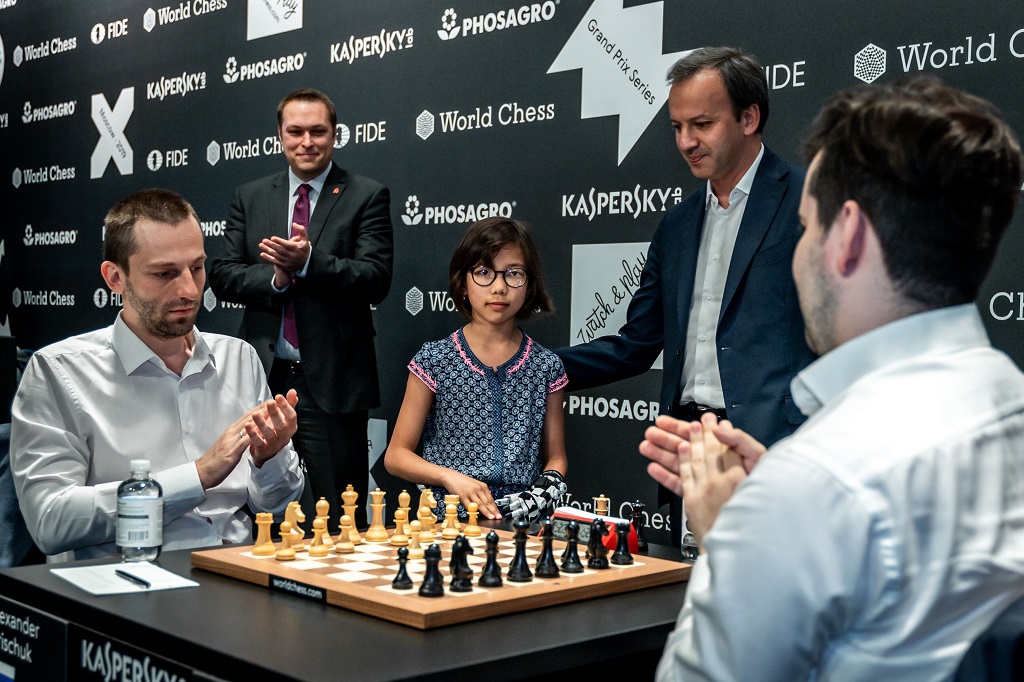


The two finalists of the Moscow Grand Prix could not have more opposite time management strategies. Alexander Grischuk is known for his studious approach while dealing with complex challenges over the board, as he tends to look for the very best continuation at every turn, trying to find "the truth of the position", so to speak. On the other hand, Ian Nepomniachtchi believes in playing quickly, saving time for critical positions while putting extra pressure on his opponents.

Young Albina Yismailova and Arkady Dvorkovich kicked off the final | Photo: Niki Riga
The difference in time management styles was clearly illustrated in game one of the final, as, despite having the white pieces, Grischuk only had three minutes left on his clock after 26 moves — Nepomniachtchi, meanwhile, had an hour and fourteen minutes left to think! Grischuk's opening preparation clearly did not surprise his younger rival. The Muscovite was not proud about his prep:
It was an opening catastrophe for me. Not just [did he] play a very good line, but also it seemed like it was the only thing he was preparing for (laughs).
Furthermore, at the end of the interview, when asked about his expectations for game two — when he will have the black pieces — Grischuk wittily responded:
For me the only good thing about today's game is that I feel like tomorrow I'm playing White again...at least, I don't think I'm supposed to get a worse position than I got today. [...] The starting position of tomorrow's game is definitely better than what I got today...at least there are some counterchances and so on.

We were all entertained | Photo: Niki Riga / World Chess
Alexander had prepared a line of the Grünfeld in which White quickly gives up an exchange:
Dmitry Andreikin recently used the same idea with 9.d5 against Gawain Jones during the IMSA World Masters Tournament in China. Jones did not take the exchange, however, and followed 9...♞e5, while Nepomniachtchi was ready to go for the lines that arise after 9...♝xc3 10.♗d2 ♝xa1 11.♕xa1 12.♞d4.
Nepo was still blitzing out his moves when Grischuk saw it necessary to spend over 36 minutes on a two-move sequence:
Alexander apparently could not remember exactly what plan to use from this position and eventually opted for 15.♕c3 ♝d7 16.♗h6 f6 17.♗xf8 ♜c8, getting back the exchange but also giving his opponent control over the c-file.

It is always nice to get a comfortable position with Black | Photo: Niki Riga / World Chess
At this point, Nepo also started taking his time...although, given Grischuk's long pauses, the time difference on the clocks barely decreased. By move 28, White had an isolated pawn on the d-file, while Black had a dangerous pawn majority on the queenside:
The computers assess this position as equal, but clearly the one on the back foot, at least psychologically, was Grischuk. Black looked for ways to increase the pressure, but could not find a satisfactory path to make something out of his still intangible edge. As Nepo put it:
Clearly Black's play should be improved somehow. [...] Maybe, basically, this setup of g3 and h4 is the only chance to hold the position, because otherwise it's unpleasant — I'm going to play h4 [myself] or maybe even g5...so it was very precise by Sasha.
Grischuk did, in fact, find the best defensive resources, until pushing his opponent to accept the draw by exchanging a pawn on the queenside:
The finalists split the point after 38.a3 bxa3, which means a decisive result on Tuesday will conclude the event then and there. Otherwise, in case of a draw, the champion will be decided the next day, on tie-breaks.

It was not at all easy with White | Photo: Niki Riga / World Chess
Commentary by GMs Evgeny Miroshnichenko and Daniil Yuffa